Travel Log, Nicaragua
Transitos at the border
Arriving at the border we pulled over, parked, and immediately were swarmed by men and boys wanting to be our "transitos", to hold our hands through the exit and entry process. Others offered to watch or wash our rig, change money, or seem to want money for nothing. We haven't used transitos before, as the border crossings have been pretty smooth. Our Spanish has been adequate to get us through the formalities, and the officials have been, if not helpful, at least not unhelpful. Most importantly, maneuvering through borders on our own is a valuable learning experience and we have many more borders ahead.
 At the El Espino crossing nothing on the Honduran side was signed except the Honduran flag painted on the side of a small hut which we somehow overlooked. There didn't appear to be any officials or official buildings, only a rope across the road. Some vendors and transitos were milling around, and a group of boys played soccer on the pavement beyond. We took our papers, stepped over the rope, and walked to the most official-looking buildings in the distance. Some of the men shouted at us and pointed to different places we should go but we ignored them, not wanting to give them a chance to get their hooks in. The building appeared to be a duty-free store but was actually Aduana, the office that issues and collects vehicle permits. (Pictured below) Once inside we found that the men were right, of course, and before we could turn our permits in we had to take them back to the blue hut for "inspection". There actually was an official there, but he and the transitos seemed to have a thing going; that's why there were no signs, uniforms or badges, and no one At the El Espino crossing nothing on the Honduran side was signed except the Honduran flag painted on the side of a small hut which we somehow overlooked. There didn't appear to be any officials or official buildings, only a rope across the road. Some vendors and transitos were milling around, and a group of boys played soccer on the pavement beyond. We took our papers, stepped over the rope, and walked to the most official-looking buildings in the distance. Some of the men shouted at us and pointed to different places we should go but we ignored them, not wanting to give them a chance to get their hooks in. The building appeared to be a duty-free store but was actually Aduana, the office that issues and collects vehicle permits. (Pictured below) Once inside we found that the men were right, of course, and before we could turn our permits in we had to take them back to the blue hut for "inspection". There actually was an official there, but he and the transitos seemed to have a thing going; that's why there were no signs, uniforms or badges, and no one  but the transitos offering information. They were even hitting on professional truck drivers who cross the border all the time! The official tried to hand the papers to a transito to hand to Kathleen, but she intercepted them, saying she wanted to deal only with him. but the transitos offering information. They were even hitting on professional truck drivers who cross the border all the time! The official tried to hand the papers to a transito to hand to Kathleen, but she intercepted them, saying she wanted to deal only with him.
Hard to tell it's Aduana, right? >
Next we walked back to the "real" aduana, where we had our passports stamped and turned in our vehicle permits so the government would know we hadn't sold our rig or moto, then drove a few yards to the Nicaraguan side to get new tourist visas, vehicle permits, and a permit for Ziggy. On this side the transitos were young boys, a swarm of 7- to 10- year- olds who followed Kathleen's every step, not taking no for an answer. She liked these little scrappers and while standing in line at aduana wondered out loud if they were hungry. Yes, they all nodded in unison! So one boy saved her place in line while she retrieved snacks from the rig and immediately the lot of 6 or 7 boys sat down on a ledge nearby and shared peanut butter-filled crackers and coconut candy from Guatemala. Left alone at last, we found the officials to be extremely efficient and helpful, if brusque, and we were out quickly and on the road again. The entire process, both sides, took less than an hour. We paid $14 for our visas, $5 for Ziggy's transit permit, and for the first time on this trip, nothing for our vehicle permits. Border policies and prices vary widely, sometimes even at the same border!
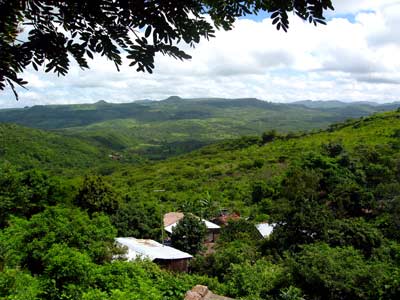 We flew down CA1, which was a fine road on the Honduran side, and even better in Nicaragua. Right away, we were surprised to notice other differences as well; healthy looking horses, for example, with good saddles and well-dressed men sitting them. And sidewalks! There were also well-built bus stops. On CA1, at least, there were very few men with machetes walking along the roadside, as in Guatemala and Honduras; people here seemed a little more sophisticated, doing their own thing and less apt to gawk at our rig as we drove by. This more worldly awareness may be an effect of the Sandinista revolution, when thousands of young"internacionalistas" flooded into Nicaragua to volunteer their help in rebuilding the country, as in Chiapas, Mexico after the Zapatista revolt. We flew down CA1, which was a fine road on the Honduran side, and even better in Nicaragua. Right away, we were surprised to notice other differences as well; healthy looking horses, for example, with good saddles and well-dressed men sitting them. And sidewalks! There were also well-built bus stops. On CA1, at least, there were very few men with machetes walking along the roadside, as in Guatemala and Honduras; people here seemed a little more sophisticated, doing their own thing and less apt to gawk at our rig as we drove by. This more worldly awareness may be an effect of the Sandinista revolution, when thousands of young"internacionalistas" flooded into Nicaragua to volunteer their help in rebuilding the country, as in Chiapas, Mexico after the Zapatista revolt.
The countryside seemed more sparsely populated, especially compared to Guatemala. For the first time we noticed rice growing, and tobacco, and huge curing barns. The capital, Managua, appeared to sprawl out forever, lacking a cohesive center, but we didn't stick around to explore it. In fact, we ended up there by mistake. After missing our peaceful countryside turn-off, we suddenly found ourselves caught in a chaotic maze of intersecting streets congested with people, vehicles and even horses. This is definitely one of the major stresses of traveling in Central America in a 26 foot camper.
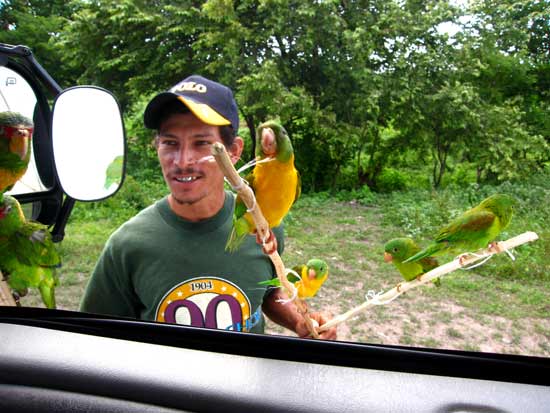
Bird-sellers are common along the highway
Granada
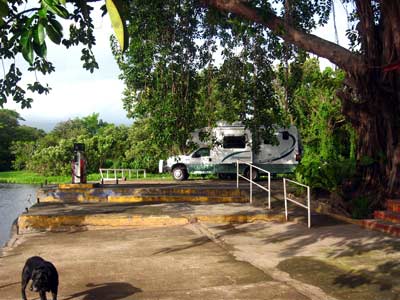 We stopped for the night in the beautiful colonial city of Granada, on the shores of Lago de Nicaragua. Fighting our way through the narrow streets to the lakefront, we followed the Centro Turistico road to the end, and got permission to park on a peaceful inlet right on the water in the shade of a huge rubber tree. Rafts of water plants floated in and out with the currents, egrets and kids competed on the shore for the same tiny fish. A fresh breeze blew in from the lake, and amazingly, with so much water, there were no mosquitoes. We stopped for the night in the beautiful colonial city of Granada, on the shores of Lago de Nicaragua. Fighting our way through the narrow streets to the lakefront, we followed the Centro Turistico road to the end, and got permission to park on a peaceful inlet right on the water in the shade of a huge rubber tree. Rafts of water plants floated in and out with the currents, egrets and kids competed on the shore for the same tiny fish. A fresh breeze blew in from the lake, and amazingly, with so much water, there were no mosquitoes.
Our Granada camp on the shores of Lake Nicaragua, Centro Turistico
Big Trouble!
We were very fortunate this was a comfortable camp. In the morning, making ready to leave for the nearby town of Masaya, our slideout wouldn't retract. The slideout is a room extension, driven by an electric motor turning a long worm gear, that extends a 7-foot section of our rig about 32" out the side. We put it out when we camp, giving us a few more precious sq. ft. of living space. Of course, we can't drive the rig when it's out. So Rus got on his throwaway clothes, grabbed his tools, crawled under the rig and spent a few hours getting really sweaty and dirty before admitting defeat. The motor was working, but grinding horribly and not engaging the worm gear, and there was no access to remove the assembly. It was HOT, the humidity was high, and we were going nowhere.
Rus walked over to a group of guys hanging out at the launch and asked if they knew a good mechanic. After some discussion among them, a mechanic was chosen, and one of them went with Rus on the moto to find him. The mechanic, Oscar, quit what he was doing, followed them back on his own moto, and got right to work. Within an hour, using only Rus' tools, he dropped the drive shaft to gain access to the slideout motor, took it apart and found the problem: some parts which connected the motor's drive to the worm gear had broken and were ground up into tiny pieces, grinding up the recess they fit into in the process . This wasn't good. Oscar was confident a machinist would be able to make new ones of better steel, but how would he know what they looked like? There was nothing left of the old ones! He took the motor, climbed back on his cycle and sped off.
Oscar at work, and with newly machined
parts we're good to go!
 |
 |
Early next afternoon Oscar was back, and showed us what he'd done. He'd found a set of good steel bearings to replace the original pot metal parts, and had the motor housing milled out to fit them perfectly. He crawled back under the rig, and two hours later gave the order to push the slideout control button, which Rus did with crossed fingers, wincing. It operated perfectly, to our immense relief! We thought we might be stuck there a long time, waiting for an express shipment of a replacement motor from the U.S., but Oscar got us on the road again in 24 hours, inexpensively and better than new.
The Lake
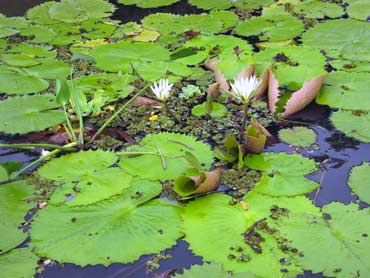 Before leaving Granada we wanted to take a tour of the islands, so we contracted with Ramon, one of the boatmen who'd been following the progress of our repairs with great interest, to take us out early the next morning. We didn't even have to ask him about Ziggy; he invited her along. Before leaving Granada we wanted to take a tour of the islands, so we contracted with Ramon, one of the boatmen who'd been following the progress of our repairs with great interest, to take us out early the next morning. We didn't even have to ask him about Ziggy; he invited her along.
There are some 365 of these tiny islands, strung out in a sort of freshwater archipelago near the shoreline east of the city. Many are the vacation estates of "Nica Ricas" or of foreigners, but a few are inhabited by ordinary people eking out their livings. Some are for sale, at prices ranging from $45,000 to a cool million for the larger ones with very nice houses. We saw one we liked for $65,000, but so what? We'd be living on two-acres in Lago Nicaragua, no drinking water, only accessible by boat, our only companion the guard we'd have to hire to watch over the place while we were in town getting drunk or renting videos!
It was interesting to see the dreams, some realized and some disillusioned, of those who found it within their means to buy their very own island. It was a pleasant cruise, with lots of unusual flora and fauna, including a colony of monkeys living on one tiny island and snow white egrets soaring over the olive tinted water or fishing in the shallows. In about two hours we saw a just fraction of this massive body of water. Lake Nicaragua is the 20th largest lake in the world and, although it is a freshwater lake, it contains sharks.

View of the Islands from nearby Volcano
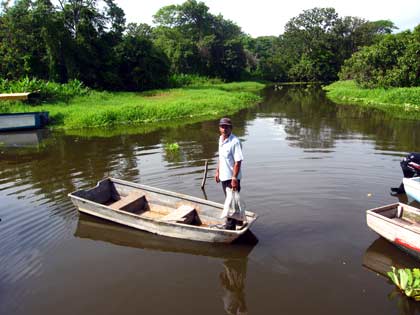
Rodolfo, the night guard and now our friend, heads for home
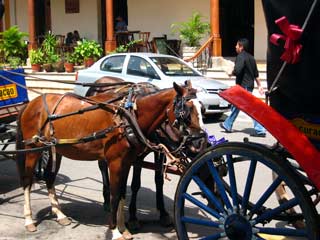 Our unanticipated extra days in Granada gave us the opportunity to get to know the town a little, and what a fine town it is, one of the most beautiful we've seen, it's grand central plaza run-down in a comfortable sort of way, with more than the usual extremes of wealth and poverty. Walking on the plaza, you're immediately assaulted by vendors, kids and drunks, all wanting money for something, or money for nothing. Granada claims to be the first city in America (we're still in America), founded in 1524 and named after the famous city in southern Spain. It must have been something to see in its heyday, when it was the shipping point for all the gold bound for Spain from the New World. Our unanticipated extra days in Granada gave us the opportunity to get to know the town a little, and what a fine town it is, one of the most beautiful we've seen, it's grand central plaza run-down in a comfortable sort of way, with more than the usual extremes of wealth and poverty. Walking on the plaza, you're immediately assaulted by vendors, kids and drunks, all wanting money for something, or money for nothing. Granada claims to be the first city in America (we're still in America), founded in 1524 and named after the famous city in southern Spain. It must have been something to see in its heyday, when it was the shipping point for all the gold bound for Spain from the New World. 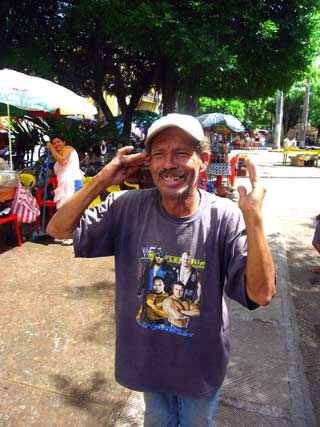
But Granada's glory days ended in 1856 when an American named William Walker set fire to the city. Walker brought Central America no end of grief when he was invited in, with his small mercenary army, by an elite faction in Nicaragua wanting to seize power after Independence. But he ended up seizing power himself, and ruled Nicaragua and parts of Honduras for two years, until he was finally driven out. As he retreated he ordered Granada burned, and only the recent flood of tourism is bringing it back, a century and a half later.
The Nicaraguan government has also instituted tax incentives to lure U.S. citizens and their dollars into the country (as if the cheap land prices weren't enough). All the real estate signs are in English, and we were told there are many retired Americans living here.
A footnote: William Walker was captured in 1858 and executed by the Hondurans, ending the first chapter of U.S. intervention in Nicaragua.
Leaving Granada and our lakeshore camp after the boat tour, we made for the artisan  markets at Masaya, a short distance away. It was a mistake. The badgering and hustling of the "guides", vehicle guards and vendors might have been bearable, but the poor workmanship of nearly everything we saw drove us from Masaya with only a pair of baby sandals, cashews and a pineapple. It was especially discouraging to see beautiful tropical hardwoods made into useless, shoddy tourist trinkets. markets at Masaya, a short distance away. It was a mistake. The badgering and hustling of the "guides", vehicle guards and vendors might have been bearable, but the poor workmanship of nearly everything we saw drove us from Masaya with only a pair of baby sandals, cashews and a pineapple. It was especially discouraging to see beautiful tropical hardwoods made into useless, shoddy tourist trinkets.
Juan el Negro tell us what to see in Granada
Images of the Masaya Market
 |
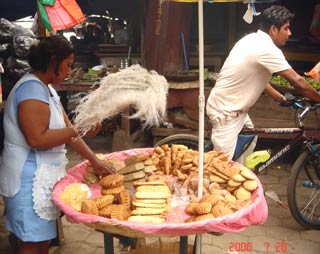 |
 |
 |
Lost on a Volcano
Kathleen wanted to see a(nother) volcano, and there were two in the immediate area, both within national parks. We started out for one, got lost, but found the other one, Reserva Nacional Volcan Mombacho. Arriving around 3pm, we were just in time to catch the last ride up the extremely steep 4 wheel drive road to the visitors center near the crater. A trail circled the  rim, but we naturally took the wrong trail and never saw it. We had a fabulous hike in another direction with views of an ancient overgrown crater and Lago Nicaragua with the islands far below that we'd just seen that morning. We found ourselves in steep, dense jungle heading in a direction that felt wrong, finally turned around and raced breathlessly back to catch the last return shuttle. rim, but we naturally took the wrong trail and never saw it. We had a fabulous hike in another direction with views of an ancient overgrown crater and Lago Nicaragua with the islands far below that we'd just seen that morning. We found ourselves in steep, dense jungle heading in a direction that felt wrong, finally turned around and raced breathlessly back to catch the last return shuttle.
Our ride down the mountain, in an old Mercedes 4-wheel-drive troop carrier, was hair-raising. The road was slick from a sudden tropical deluge and wet vegetation on the concrete cobbles. But the driver knew the road and his vehicle, he kept that heavy truck in granny gear the whole way down. We crawled on, accompanied by screams and laughter every time a sharp turn dumped water on us which had collected on the canvas cover. Back at the parking area we made a run for it, reached our rig soaking wet and holed up for the night inside the park entrance. It was a beautiful place to camp, green and lush, with guitar music and singing from a nearby church wafting through the forest.
Impressions
 It was harder for us in Nicaragua, as it's probably harder for the Nicaraguans themselves. All the years of repression under the Somoza regime, followed by the Sandinista revolution, then the Contra war, have left this beautiful country in a sad state. Many people are unemployed, idle and seem desperate. By now we were used to being among people who were very poor, but here in Nicaragua, as American citizens, it was harder to witness. The Contra war only cost the U.S. $20 million, pocket change, but combined with the embargo it was instrumental in derailing the reforms of the Sandinistas, and left the economy in worse shape than what they'd inherited from Somoza. It was harder for us in Nicaragua, as it's probably harder for the Nicaraguans themselves. All the years of repression under the Somoza regime, followed by the Sandinista revolution, then the Contra war, have left this beautiful country in a sad state. Many people are unemployed, idle and seem desperate. By now we were used to being among people who were very poor, but here in Nicaragua, as American citizens, it was harder to witness. The Contra war only cost the U.S. $20 million, pocket change, but combined with the embargo it was instrumental in derailing the reforms of the Sandinistas, and left the economy in worse shape than what they'd inherited from Somoza.
Honduras still shows scars from all the years of economic exploitation and political meddling  by the powerful United Fruit Company, but here in Nicaragua the damage is more recent and profound. Surprisingly, we didn't feel hostility from anyone we encountered in Nicaragua. We did notice an initial reserve or guardedness in many people which dissolved into friendliness when we made the first move. And from others we experienced badgering, aggressiveness and the hustle that come from people in dire straits. Eventually it wore thin on us. Photo: Brahva and Victoria are two Nicaraguan beers, tasting pretty much like all the others by the powerful United Fruit Company, but here in Nicaragua the damage is more recent and profound. Surprisingly, we didn't feel hostility from anyone we encountered in Nicaragua. We did notice an initial reserve or guardedness in many people which dissolved into friendliness when we made the first move. And from others we experienced badgering, aggressiveness and the hustle that come from people in dire straits. Eventually it wore thin on us. Photo: Brahva and Victoria are two Nicaraguan beers, tasting pretty much like all the others
Heading south
 On our way south we turned east at Rivas and stopped in San Jorge on the southwestern shores of Lago de Nicaragua to view the volcanic Isla Ometepe. After romping with Ziggy on the beach we followed some dirt roads away from town to get a feel for the countryside. Images of the homes scattered in the hills and along the lakeshore remain vivid imprints for us of rural life in Nicaragua. Houses of wood or earthen blocks are usually small and heavily weathered. The yards are as lived in as the houses, with youngsters outside, goats or maybe a pig, and chickens scratching in the dirt, a patch of corn, and usually some flowers. We decided to skip a trip to Ometepe, though other travelers recommended it. Jamie's wedding in September was coming up, pushing us to make plans for returning home. We were ready for Costa Rica and then Panama, to see what we could find to ship Turtle to South America. On our way south we turned east at Rivas and stopped in San Jorge on the southwestern shores of Lago de Nicaragua to view the volcanic Isla Ometepe. After romping with Ziggy on the beach we followed some dirt roads away from town to get a feel for the countryside. Images of the homes scattered in the hills and along the lakeshore remain vivid imprints for us of rural life in Nicaragua. Houses of wood or earthen blocks are usually small and heavily weathered. The yards are as lived in as the houses, with youngsters outside, goats or maybe a pig, and chickens scratching in the dirt, a patch of corn, and usually some flowers. We decided to skip a trip to Ometepe, though other travelers recommended it. Jamie's wedding in September was coming up, pushing us to make plans for returning home. We were ready for Costa Rica and then Panama, to see what we could find to ship Turtle to South America.

Adios, Nicaragua. Que le vaya bien!
|

